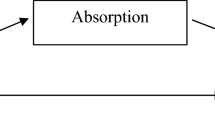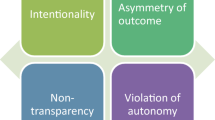Abstract
This paper reviews interactive technological approaches to improve mindfulness and fills a gap in the literature by using technology to target aspects of mindfulness that are missing in scientific research. Interactive approaches to train mindfulness are presented and discussed in relation to Bergomi’s conceptual mindfulness model and Vago and Silbersweig’s neurobiological approach for cognitive, emotional, and behavioral processes. Based on existing interactive technologies, key design guidelines are developed to investigate the delivery of mindfulness by interactive media, including the design recommendations of personalization, gamification, and social features for the S-ART component intention and motivation; biofeedback training and narrative for emotion regulation; moral dilemmas, perspective taking, and cooperative design for prosociality; and explorative self-reflection, visualization and immersive feedback, and the integration of internal stimuli for self-transcendence. The paper recommends to apply a more extensive definition of mindfulness, which includes ethical and spiritual development. As a design premise for mindfulness technology, it is advised to strive for embodied experiences that adapt to the user’s internal state.
Similar content being viewed by others
References
Ahn, S. J., Le, A. M. T., & Bailenson, J. (2013). The effect of embodied experiences on self-other merging, attitude, and helping behavior. Media Psychology, 16(1), 7–38.
Amihai, I., & Kozhevnikov, M. (2014). Arousal vs. relaxation: A comparison of the neurophysiological and cognitive correlates of vajrayana and theravada meditative practices. PloS One, 9(7), e102990.
Baer, R. (2015). Ethics, values, virtues, and character strengths in mindfulness-based interventions: a psychological science perspective. Mindfulness, 6(4), 956–969.
Bergomi, C., Tschacher, W., & Kupper, Z. (2014). Construction and first validation of the comprehensive inventory of mindfulness experiences. Diagnostica, 60(3), 111–125.
Bessière, K., Seay, A. F., & Kiesler, S. (2007). The ideal elf: identity exploration in World of Warcraft. Cyberpsychology & Behavior, 10(4), 530–535.
Brown, E., & Cairns, P. (2004). A grounded investigation of game immersion. In Extended Abstracts of the 2004 Conference on Human Factors in Computing Systems, pp. 1297–1300: ACM.
Chiesa, A. (2013). The difficulty of defining mindfulness: current thought and critical issues. Mindfulness, 4(3), 255–268.
Csikszentmihalyi, I. S. (1992). Optimal experience: Psychological studies of flow in consciousness: Cambridge: Cambridge University Press.
Dahl, C. J., Lutz, A., & Davidson, R. J. (2015). Reconstructing and deconstructing the self: Cognitive mechanisms in meditation practice. Trends in Cognitive Sciences, 19(9), 515–523.
Davis, J. H., & Vago, D. R. (2013). Can enlightenment be traced to specific neural correlates, cognition, or behavior? No, and (a qualified) yes. Frontiers in Psychology, 4, 870.
DeRosier, M. E., Craig, A. B., & Sanchez, R. P. (2012). Zoo U: a stealth approach to social skills assessment in schools. Advances in Human-Computer Interaction, 2012, 7.
Fernández-Aranda, F., Jiménez-Murcia, S., Santamaría, J. J., Gunnard, K., Soto, A., Kalapanidas, E., et al. (2012). Video games as a complementary therapy tool in mental disorders: PlayMancer, a European multicentre study. Journal of Mental Health, 21(4), 364–374.
Gackenbach, J., & Swanston, D. (2015). Effects of video game play versus meditation/prayer in waking and dreaming experiences. Association for Transpersonal Psychology, 47(2), 188–218.
Games Learning Society (2017). Games+Learning+Society Center. Retrieved January 25, 2017, from http://www.gameslearningsociety.org/kaydor_microsite/.
Ganesh, S., van Schie, H. T., de Lange, F. P., Thompson, E., & Wigboldus, D. H. (2012). How the human brain goes virtual: distinct cortical regions of the person-processing network are involved in self-identification with virtual agents. Cerebral Cortex, 22(7), 1577–1585.
Gilpin, R. (2008). The use of Theravāda Buddhist practices and perspectives in mindfulness-based cognitive therapy. Contemporary Buddhism, 9(2), 227–251.
Greitemeyer, T. (2013). Playing video games cooperatively increases empathic concern. Social Psychology, 44(6), 408–413.
Greitemeyer, T., Osswald, S., & Brauer, M. (2010). Playing prosocial video games increases empathy and decreases schadenfreude. Emotion, 10(6), 796–802.
Grizzard, M., Tamborini, R., Lewis, R. J., Wang, L., & Prabhu, S. (2014). Being bad in a video game can make us more morally sensitive. Cyberpsychology, Behavior, and Social Networking, 17(8), 499–504.
Holmes, E. A., James, E. L., Coode-Bate, T., & Deeprose, C. (2009). Can playing the computer game “Tetris” reduce the build-up of flashbacks for trauma? A proposal from cognitive science. PloS One, 4(1), e4153.
Hudlicka, E. (2011). Virtual coach for mindfulness meditation training. In Proceedings of AI and Health Communication (AAAI 2011 Spring Symposium), p. 17–24: AAAI.
Jones, C. M., Scholes, L., Johnson, D., Katsikitis, M., & Carras, M. C. (2014). Gaming well: links between videogames and flourishing mental health. Frontiers in Psychology, 5(260).
Kitson, A., Riecke, B. E., & Vidyarthi, J. (2014). Sonic Cradle: investigating meditative aspects of an interactive technology. In GRAND NCE 2014, pp. 1–4: GRAND.
Kosunen, I., Salminen, M., Järvelä, S., Ruonala, A., Ravaja, N., & Jacucci, G. (2016). RelaWorld: neuroadaptive and immersive virtual reality meditation system. In Proceedings of the 21st International Conference on Intelligent User Interfaces, pp. 208–217: ACM.
Lenggenhager, B., Mouthon, M., & Blanke, O. (2009). Spatial aspects of bodily self-consciousness. Consciousness and Cognition, 18(1), 110–117.
Levinson, D. B., Stoll, E. L., Kindy, S. D., Merry, H. L., & Davidson, R. J. (2014). A mind you can count on: validating breath counting as a behavioral measure of mindfulness. Frontiers in Psychology, 5(1202).
Lomas, T. (2016). Recontextualizing mindfulness: Theravada Buddhist perspectives on the ethical and spiritual dimensions of awareness. Psychology of Religion and Spirituality. Advance online publication.
Long, K., & Vines, J. (2013). Mind pool: encouraging self-reflection through ambiguous bio-feedback. In CHI'13 Extended Abstracts on Human Factors in Computing Systems, pp. 2975–2978: ACM.
Mani, M., Kavanagh, D. J., Hides, L., & Stoyanov, S. R. (2015). Review and evaluation of mindfulness-based iPhone apps. JMIR mhealth and uhealth, 3(3), e82.
Pepping, C. A., Walters, B., Davis, P. J., & O’Donovan, A. (2016). Why do people practice mindfulness? An investigation into reasons for practicing mindfulness meditation. Mindfulness, 1–6.
Personalized Learning Games (2015). Zoo U Research Whitepaper [White paper]. Retrieved January 25, 2017, from http://www.centervention.com/wp-content/uploads/2016/10/ZooU_Whitepaper_16.pdf.
Piron, H. (2001). The meditation depth index (MEDI) and the meditation depth questionnaire (MEDEQ). Journal for Meditation and Meditation Research, 1(1), 69–92.
Plaza, I., Demarzo, M. M. P., Herrera-Mercadal, P., & García-Campayo, J. (2013). Mindfulness-based mobile applications: literature review and analysis of current features. JMIR mhealth and uhealth, 1(2), e24.
Prpa, M., Cochrane, K., & Riecke, B. E. (2016). Hacking Alternatives in 21st Century: designing a bio-responsive virtual environment for stress reduction. In Pervasive Computing Paradigms for Mental Health, pp. 34–39: Springer.
Purser, R. E., & Loy, D. (2013). Beyond McMindfulness. The Huffington Post. Retrieved January 25, 2027, from http://www.huffington-post.com/ron-purser/beyond-mcmindfulness_b_3519289.html.
Riva, G., Botella, C., Baños, R., Mantovani, F., García-Palacios, A., Quero, S., et al. (2015). Presence-inducing media for mental health applications. In Immersed in Media, pp. 283–332: Springer.
Sauer, S., Walach, H., Schmidt, S., Hinterberger, T., Lynch, S., Büssing, A., et al. (2013). Assessment of mindfulness: Review on state of the art. Mindfulness, 4(1), 3–17.
Shamekhi, A., & Bickmore, T. (2015). Breathe with me: a virtual meditation coach. In Intelligent Virtual Agents 2015, pp. 279–282: Springer.
Shaw, C. D., Gromala, D., & Seay, A. F. (2007). The meditation chamber: enacting autonomic senses. Proceedings of ENACTIVE/07, pp. 405–408: ACROE.
Sliwinski, J., Katsikitis, M., & Jones, C. M. (2015). Mindful gaming: how digital games can improve mindfulness. In Human-Computer Interaction–INTERACT 2015, pp. 167–184. Springer. doi:10.1007/978-3-319-22698-9_12.
Vidyarthi, J., & Riecke, B. E. (2013). Mediated meditation: cultivating mindfulness with Sonic Cradle. In CHI'13 Extended Abstracts on Human Factors in Computing Systems, pp. 2305–2314: ACM.
Vidyarthi, J., Riecke, B. E., & Gromala, D. (2012). Sonic Cradle: designing for an immersive experience of meditation by connecting respiration to music. In Proceedings of the Designing Interactive Systems Conference DIS '12, pp. 408–417: ACM.
Vago, D. R., & Silbersweig, D. A. (2012). Self-awareness, self-regulation, and self-transcendence (S-ART): a framework for understanding the neurobiological mechanisms of mindfulness. Frontiers in Human Neuroscience, 6(296), 1–30.
Computer Programs
Crystals of Kaydor [Computer software]. (2014). Madison: Games Learning Society.
Insight Timer [Computer software]. (2017). San Francisco: Insight Network.
Lemmings [Computer software]. (1991). Edinburgh: DMA Design.
Papers, Please [Computer software]. (2013). Mount Pleasant, 3909.
SoundSelf [Computer software]. (2017). Austin: Robin Arnott.
Spire [Computer software]. (2017). San Francisco: Spire.
Tetris [Computer software]. (1984). Moscow: Alexey Pajitnov.
The Settlers [Computer software]. (1994). Düsseldorf: Blue Byte Software.
Zoo U [Computer software]. (2015). Durham: 3C Institute.
Author information
Authors and Affiliations
Corresponding author
Ethics declarations
Conflict of Interest
The authors declare that they have no conflict of interest.
Research Involving Human Participants and/or Animals
This article does not contain any studies with human participants or animals performed by any of the authors.
Rights and permissions
About this article
Cite this article
Sliwinski, J., Katsikitis, M. & Jones, C.M. A Review of Interactive Technologies as Support Tools for the Cultivation of Mindfulness. Mindfulness 8, 1150–1159 (2017). https://doi.org/10.1007/s12671-017-0698-x
Published:
Issue Date:
DOI: https://doi.org/10.1007/s12671-017-0698-x




